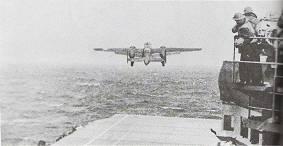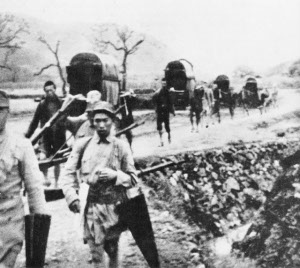![]() The Pacific War Online Encyclopedia
The Pacific War Online Encyclopedia
|
| Previous: Dolphin, U.S. Submarine | Table of Contents | Next: Doolittle, James Harold |

U.S. Navy
James Doolittle was a former Army aviator who became the country’s leading civilian test pilot between the wars. He was recalled to active duty well before the attack on Pearl Harbor and helped organize the expansion of the Air Corps. In April 1942, Doolittle was ordered to plan a carrier raid on Tokyo. Because of the weakness of the U.S. Navy at this point in the war, and the anticipated strong defenses of the Japanese homeland, the raid was conducted by medium land-based bombers whose crews were specially trained at carrier takeoffs. Because landing back at the carrier was out of the question, the bombers were to proceed to China and reinforce the Nationalist air forces.
The directive to launch a raid on Japan originated with Roosevelt, but the unlikely source for the idea of having land-based aircraft attack from a carrier was a submarine officer on King's staff. King passed the suggestion on to Arnold, who had Doolittle perform a feasibility study that identified the B-25 as the only bomber in the American inventory capable of taking off from a carrier, attacking Tokyo, and flying on to friendly bases in China.
Doolittle selected and trained a
group of 24 volunteer crews from 17
Bombardment Group, which had been flying B-24s longer than
any other formation in the Army Air Forces. The crews were trained
in
great secrecy at Eglin Field, Florida, where a naval aviator,
Lieutenant Henry F. Miller, provided instruction in very short
takeoffs. The crews were also trained in low-level flying and
night navigation. They were to approach their targets at low
altitude, then climb to 1500' (460m) for their bomb runs. Their
aircraft were specially modified for increased range, including
the installation of additional fuel
tanks in place of the ventral gun turret, and their Norden
bombsights were removed. The crews were trained to use a simple
"Mark Twain" bombsight in place of the Norden, which was
considered too sensitive to use on a raid where there was a high
probability of the Japanese recovering a crashed American
aircraft.
The crews and sixteen of the aircraft embarked on the Hornet
at Alameda
and sortied for Japan on 2 April 1942. The Hornet task
force was joined en route by Halsey’s
task force built around the Enterprise,
which would provide fighter
cover.
U.S. Navy. Via ibiblio.org
The original plan called for a
takeoff from 450 miles out
timed so that the bombers would arrive over the target after
dark. However, as early as 10 April, the Japanese had hints
from traffic analysis
that an American carrier force might be headed for Japan. The task
force was spotted by Japanese picket boat Nitto
Maru #23 at 0738 on 18
April 1942, while
still 800
miles from Japan. The picket
boat was promptly sunk by gunfire, but not
before it was able to transmit a warning to Tokyo. Halsey ordered
Doolittle to launch at once rather
than further risk
half the Navy’s carrier strength, and Doolittle's aircraft took to
the air at 0818. As a result of the early launch, the
raiders arrived in
daylight, but the Japanese defenses were taken by surprise and Doolittle's
fliers made
their bombing runs unscathed.
The Japanese had received the picket boat warning, but assumed
that the Americans planned a raid with conventional carrier
aircraft, and calculated that the raid could not be launched until
the next day. The main Japanese carrier strike force had just
completed a raid into the Indian
Ocean, far to the west, and was unable to intercept the Hornet
task force, which made a clean escape.
The material damage done by the
raid was
relatively minor. The raiders each carried three 500 lb (227 kg)
demolition bombs and an
incendiary cluster, and these were targeted on oil stores, factories, and military
establishments. One bomb hit the carrier Ryuho, which was
undergoing reconstruction at Yokosuka
Navy Yard, delaying its
completion by some months. The other damage was quickly repaired.
Some of the bombs went wide of their targets and hit heavily
populated neighborhoods, which provided a pretext for the later
mistreatment of captured raiders.

U.S. Army. Via ibiblio.org
Because of the early takeoff, none of
the raiders made it to
friendly Chinese airfields.
One
plane, which suffered a
carburetor
malfunction, landed at Vladivostok
where the crew were interned
by the Russians.
Although a favorable tail wind allowed the other fifteen aircraft
to reach the China coast, miserable weather and night conditions
prevented any of them from landing at the Chinese airfields. The
aircraft crash-landed or their crews bailed out after their
aircraft
ran out of fuel. Three raiders were killed bailing out or in crash
landings. Another eight raiders fell into Japanese
hands. The
remainder were spirited out to Chungking
and, eventually,
back to the United States.
The Japanese were outraged by the attack, which caused the military great loss of face. Sugiyama Gen felt particularly humiliated, and persuaded Tojo to pass retroactive regulations subjecting captured bomber crews to the death penalty. The eight raiders captured by the Japanese were accused of strafing civilians and were treated as war criminals, three being executed by firing squad and another dying in captivity. The raid also muted most of the opposition to Yamamoto’s Midway operation, though the decision to proceed with the operation had already been made and the plan presented to the Emperor two days earlier. This ill-conceived operation would prove disastrous for the Japanese. The Doolittle raid was a tremendous morale booster for the Allied public at a time when good news was very scarce. If the measure of success of a military action is its political results, then the Doolittle raid must be regarded as a resounding military success, notwithstanding its negligible material impact.
The most concrete military effect of the raid was that the
Japanese retained four fighter
groups in Japan in 1942-1943 that were badly needed elsewhere.
The East China Campaign. Chiang Kai-shek had
only reluctantly agreed to the raid, fearing the likely Japanese
reaction. He was also told few details of the plan, since the
Americans did not trust Chinese operational security (for example,
the Americans knew from ULTRA
that the Japanese were reading Chinese codes.) Chiang did not give
his consent for the raiders to land on Chinese airfields until 28
March, and it was not until 2 April that he was told the
approximate number of aircraft involved and the airfields they
would be landing at.
Chiang's fears were well-founded. In
retaliation for Chinese involvement in the Doolittle Raid, and
possibly because they mistakenly believed that the raid had been
launched from China (Peattie et al. 20111), the Japanese
Army went on a rampage in China,
killing an
estimated quarter of a million Chinese civilians. Some 140,000
Japanese troops from five divisions
and three independent mixed brigades
of 13 Army participated
in
a sweep of airfields in Chekiang
and
Kiangsi provinces in mid-May
1942 and also stripped the
Chekiang-Kiangsi
rail line of
rolling stock. After linking up with two divisions from 11 Army at Nanchang, the Japanese pulled
out of
the area. Chinese
military casualties were
estimated at 40,000, while the Japanese suffered 1600 dead and
28,000
wounded.
References
Craven and Cate (1952; accessed 2012-8-12)
The Pacific War Online Encyclopedia © 2007-2010, 2015, 2016 by Kent G. Budge. Index